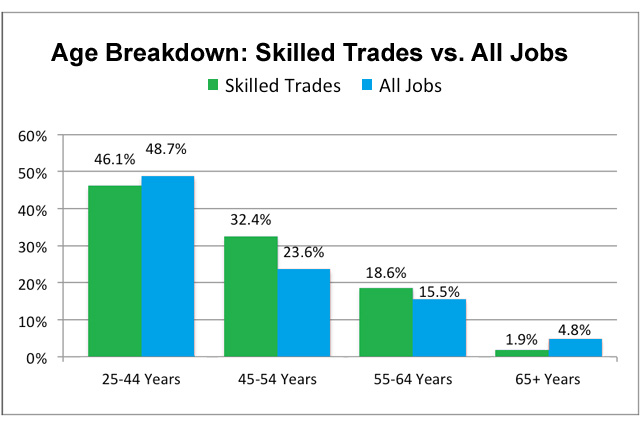Labor Shortages Loom as Most-In-Demand Group of Workers Retire
 Every year, ManpowerGroup--a high-profile workforce services firm--conducts a study to determine which positions are the hardest to fill for employers. The past three years, the same item has ranked #1 on the list: skilled trades.
Every year, ManpowerGroup--a high-profile workforce services firm--conducts a study to determine which positions are the hardest to fill for employers. The past three years, the same item has ranked #1 on the list: skilled trades."Skilled trades" refers to a number of occupations which require specific hands-on skills, such as machinists, welders, plumbers, and electricians. These occupations are a critical part of the nation's workforce, and play key roles in the fields of manufacturing, construction, and repair.
Why is there a shortage of workers in the skilled trades? According to EMSI (Economic Modeling Specialists International), age is an important factor. Right now, 53% of skilled trades workers are over the age of 45. That figure is about 10% higher than usual, when compared to the average across all jobs. Furthermore, very few skilled-trade workers keep working after the age of 65--far fewer than in other occupations. Skilled trades jobs are physically demanding, and workers can't afford to put off retirement any longer than necessary.
 There's a growing concern that, as the baby-boom generation of skilled-trade workers approaches retirement, there won't be enough younger workers trained to replace them. This leads us to another factor in the shortage of workers in the skilled trades: educational focus. At present, high schools focus almost entirely on preparing students for academic studies at 4-year universities. Not so long ago, that focus would have been shifted more towards vocational and technical schools. Many even claim that this is the result of elitism--that academics hold the skilled trades in disdain, despite their crucial importance to society. Regardless, our education system will need to recognize that a 4-year university isn't the best fit for every student, and that vocational schools can offer students valuable skills which can result in immediate employment. Achieving this balance will help mitigate the impending shortages of skilled-trade workers.
There's a growing concern that, as the baby-boom generation of skilled-trade workers approaches retirement, there won't be enough younger workers trained to replace them. This leads us to another factor in the shortage of workers in the skilled trades: educational focus. At present, high schools focus almost entirely on preparing students for academic studies at 4-year universities. Not so long ago, that focus would have been shifted more towards vocational and technical schools. Many even claim that this is the result of elitism--that academics hold the skilled trades in disdain, despite their crucial importance to society. Regardless, our education system will need to recognize that a 4-year university isn't the best fit for every student, and that vocational schools can offer students valuable skills which can result in immediate employment. Achieving this balance will help mitigate the impending shortages of skilled-trade workers.Some occupations are feeling this shortage more acutely than others. Over 60% of electricians, electrical repairers, and machine maintenance workers are over the age of 45. Welders and machinery mechanics are only slightly better off--59% of these workers are over 45 years old. Large amount of workers will be retiring from these professions at a rapid rate, and very soon.
A Direction for The Future
To ensure that this shortage of workers doesn't cause too many problems, the skilled trade industries will need to make sure that wages remain competitive into the future. Otherwise, workers will simply opt to apply their skills to more profitable endeavors, thereby accelerating the issue.Furthermore, young talent will need to be encouraged to receive vocational education and/or apprenticeships, and trained to fill the positions left by retirees. This will have positive repercussions for not only the skilled trades but for the general economy as well. Hiring younger and more technologically savvy laborers will be very beneficial to advance manufacturers and construction firms for years to come.
About
Privacy Policy
Contact Us
Submit a Resource
